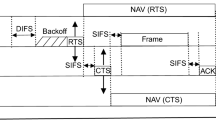Abstract
The ubiquitous nature of the Internet of Things (IoT) constitutes a set of stringent quality of service (QoS) requirements from the underlying 5G network. To address the issues, this paper proposes an enhancement for the channel access period (CAP) of the widely used IEEE 802.15.3C (millimeter wave (mmW)) standard using a priority mechanism that fulfills the requirement of prioritized channel access for the IoT based applications. According to the hybrid medium access control (MAC) protocol of the IEEE 802.15.3C, to reserve time-division multiple access (TDMA) based slot in channel time allocation period (CTAP), a node will first send a channel time allocation (CTA) request to piconet controller (PNC) by using carrier-sense multiple access with collision avoidance (CSMA/CA) mechanism in the contention-access period (CAP). After successful delivery of CTA’s request, PNC will reserve a CTA for a specific node. However, there is no guarantee that a node will get a channel in the contention process in the existing standard. Hence, the existing CAP mechanism could demonstrate a bottleneck for a data sending device in terms of less delay and high throughput. To solve this issue, we first design a numerical model of CAP using the IEEE 802.15.3C standard’s specification, and then we propose a priority-based mechanism with three priority classes: high priority (HP), medium priority (MP), and low priority (LP) with each class having different contention windows (CW) range that makes the value of backoff period shorter. To evaluate the performance of the proposed mechanism, modifications are applied to the proposed numerical model. The performance comparison is conducted among prioritized classes devices in terms of transmission delay, channel access delay, and throughput. The conducted evaluations include two types of data rates i.e., 1.5 Gbps and 3 Gbps. The proposed scheme shows promising results for a node that requires high priority in an IoT environment.
Access this chapter
Tax calculation will be finalised at checkout
Purchases are for personal use only
Similar content being viewed by others
References
Whitmore, A., Agarwal, A., Da, X.L.: The internet of things - a survey of topics and trends. Inf. Syst. Front. 17, 261–74 (2015)
Atzori, L., Lera, A., Morabito, G.: Understanding the internet of things: definition potentials and societal role of a fast evolving paradigm. Ad Hoc Netw. 56, 122–40 (2017)
Agiwal, M., Roy, A., Saxena, N.: Next generation 5G wireless networks: a comprehensive survey. IEEE Commun. Surv. Tutorials 18, 1617–55 (2017)
Deliverable D6.6, METIS: Final report on the METIS system concept and technology roadmap (2015)
Shah, S.H., Yaqoob, I.: A survey: Internet of Things (IoT) technologies applications and challenges. Smart Energy Grid Eng., 381–85 (2016)
Al-Fuqaha, A., Guizani, M., Mohammadi, M., Aledhari, M., Ayyash, M.: Internet of things: a survey on enabling technologies, protocols and applications. IEEE Commun. Surv. Tutorials 17(4), 2347–76 (2015)
Palattella, M., et al.: Internet of things in the 5G era: enablers, architecture and business models. IEEE J. Sel. Areas Commun. 34(3), 510–27 (2016)
Andrews, J.G., et al.: What will 5G be? IEEE J. Sel. Areas Commun. 32(6), 1065–82 (2014)
https://datatracker.ietf.org/wg/6tisch/about/, https://datatracker.ietf.org/wg/6tisch/documents/
Rappaport, T., et al.: Millimeter wave mobile communications for 5G cellular: it will work! IEEE Access 1, 335–349 (2013)
IEEE 802.15.3c Part 15.3: Wireless medium access control (MAC) and physical layer (PHY) specifications for high rate wireless personal area networks (WPANs) amendment 2: Millimeter-wave-based alternative physical layer extension (2009)
IEEE 802.11ad. Part 11: Wireless LAN medium access control (MAC) and physical layer (PHY) specifications - amendment 3: Enhancements for very high throughput in the 60 GHz band (2012)
Rangan, S., Rappaport, T., Erkip, E.: Millimeter wave cellular wireless networks: Potentials and challenges. Proc. IEEE 102, 366–385 (2014)
Caglar, T., Korpeoglu, I.: 60 GHz wireless data center networks: a survey. Comput. Netw. 185, 107730 (2021)
Bhattacharjee, A., Bhattacharjee, R., Bose, S.K.: An approach for mitigation of beam blockage in mmWave based indoor networks. IEEE Internet Things J. 8, 14607–14622 (2021)
Akbar, M.S., Yu, H., Cang, S.: TMP: tele-medicine protocol for slotted 802.15. 4 with duty-cycle optimization in wireless body area sensor networks. IEEE Sens. J. 17(6), 1925–1936 (2016)
Akbar, M.S., Yu, H., Cang, S.: Delay, reliability, and throughput based QoS profile: a MAC layer performance optimization mechanism for biomedical applications in wireless body area sensor networks. J. Sens. 2016 (2016)
Akbar, M.S., Yu, H., Cang, S.: IEEE 802.15. 4 frame aggregation enhancement to provide high performance in life-critical patient monitoring systems. Sensors 17(2), 241 (2017)
Author information
Authors and Affiliations
Corresponding author
Editor information
Editors and Affiliations
Rights and permissions
Copyright information
© 2022 ICST Institute for Computer Sciences, Social Informatics and Telecommunications Engineering
About this paper
Cite this paper
Akbar, M.S., Hussain, Z., Sheng, Q.Z., Mukhopadhyay, S. (2022). An Enhancement to Channel Access Mechanism for the IEEE 802.15.3C MillimeterWave (5G) Standard to Support Stringent QoS Requirements of IoT. In: Hussain, W., Jan, M.A. (eds) IoT as a Service. IoTaaS 2021. Lecture Notes of the Institute for Computer Sciences, Social Informatics and Telecommunications Engineering, vol 421. Springer, Cham. https://doi.org/10.1007/978-3-030-95987-6_2
Download citation
DOI: https://doi.org/10.1007/978-3-030-95987-6_2
Published:
Publisher Name: Springer, Cham
Print ISBN: 978-3-030-95986-9
Online ISBN: 978-3-030-95987-6
eBook Packages: Computer ScienceComputer Science (R0)




